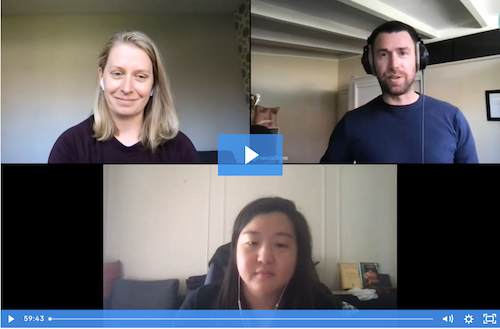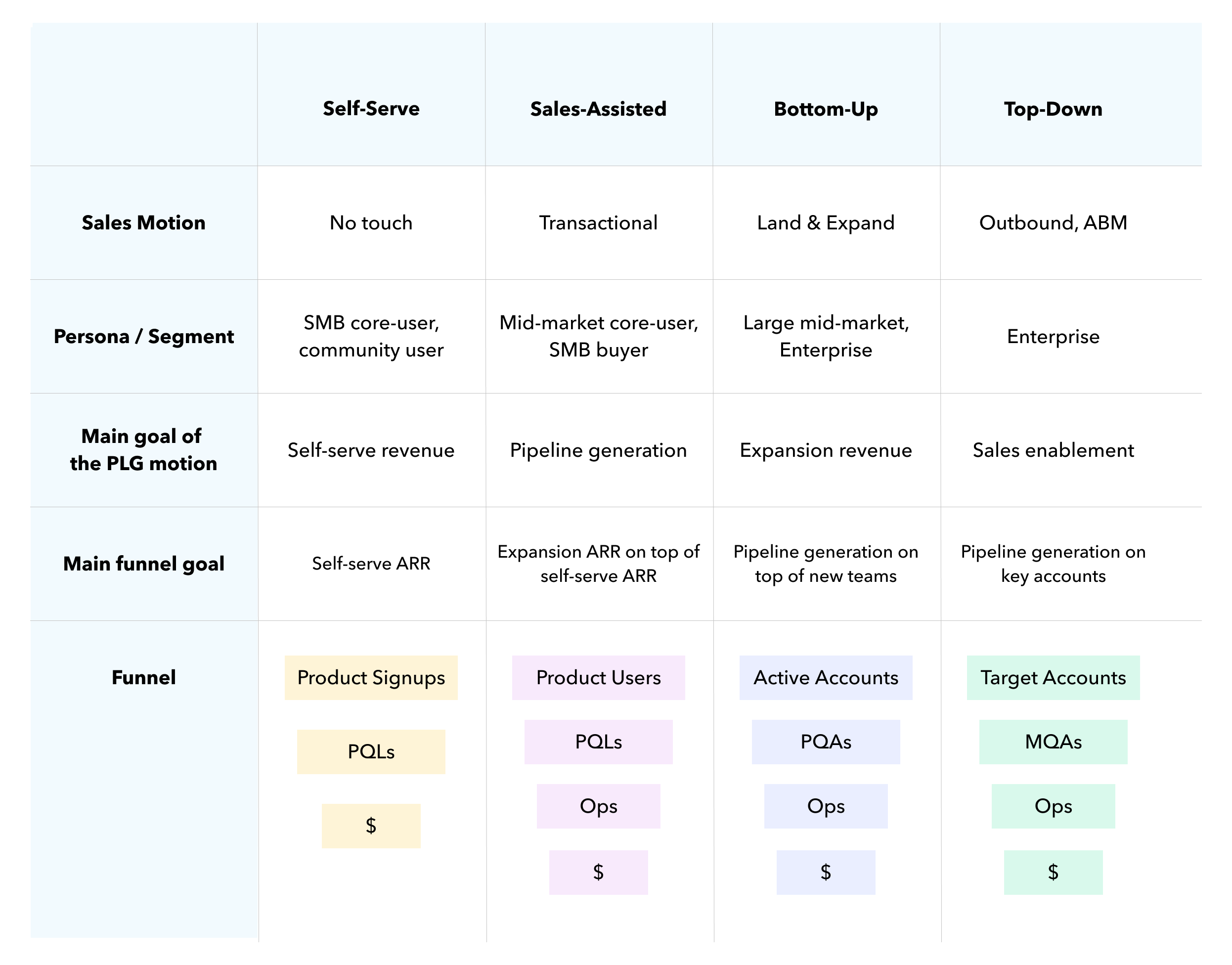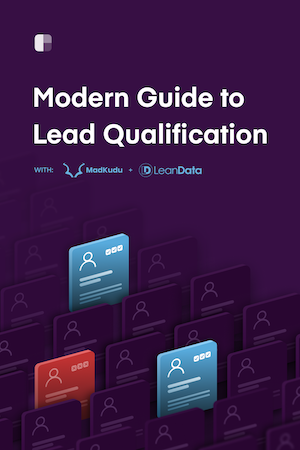4 monetization funnels for PLG companies moving upmarket
Product-led growth and self-serve aren't synonymous.
Growing product-led companies will often have multiple go-to-market motions in addition to their self-serve track. Your customer needs and business strategies start becoming more complex as buying journeys — and who is involved in them — become more complex.
As growth advisor Elena Verna and Francis Brero, co-founder of MadKudu, explain in their video on How to scale your PLG motion with an account-centric approach: the idea of one size not fitting everyone applies to how you market and sell to other businesses.
Today, we'll go through Francis and Elena's overview of the four main types of motions, or monetization funnels, that a product-led growth (PLG) company can incorporate — and why multiple funnels become a need, especially as you start to move upmarket.
Why you get stuck when trying to move upmarket
Elena and Francis often see companies frustrated when they try to sell to enterprise buyers after initial success with a strong self-serve motion, but something just isn't working. Their product may be popular — enterprise employees out there may even be enthusiastic power users, high NPS scores coming in left and right — and yet that enthusiasm doesn't turn into sustainable growth.
 Elena and Francis explain how to turn product users into enterprise pipeline in their webinar on
how to scale your PLG funnel — watch on demand!
Elena and Francis explain how to turn product users into enterprise pipeline in their webinar on
how to scale your PLG funnel — watch on demand!
Here's how this scenario might play out. Let's say your business is a SaaS company that makes a design tool. Designers can swipe their credit cards to get a subscription. That works well for freelancers, individual users, and even small design agencies, and you experience lots of growth in this market segment.
You start selling into larger teams and companies but notice that pipeline is shrinking, not expanding.
Maybe those designers who love the product can't simply swipe a card to pay for larger deals or figure out how to navigate stringent compliance, privacy, and security rules. Plus, the design team is so large that switching from their previous design tool is a big task that needs a lot of stakeholders to manage; it's not a decision that one designer can make on their own, even if they're your #1 fan.
So you're not scaling sales to larger accounts — and while you've started focusing on enterprise buyers, your self-serve business starts to dry up.
The problem is that a one-size-fits-all funnel limits your ability to successfully move upmarket and keep expanding. Customers often have different buying behaviors and needs across market segments — which call for different monetization funnels, or buying journeys, that cater to those needs.
 "The exact same funnel is going to lead to catastrophe because every company out there different. Understanding what is the best journey for your different types of customers is really critical."
"The exact same funnel is going to lead to catastrophe because every company out there different. Understanding what is the best journey for your different types of customers is really critical."- Francis Brero, Co-founder at MadKudu
[from How to scale your PLG motion with an account-centric approach]
Designing additional funnels for different buying journeys
So, what do you do? You start layering in sales motions to specialize in different strategies in response to those various buying needs.
That way you have paths that account for the different needs of a lead who swipes a credit card versus the needs of a buying committee of an opportunity you want to win. Your purchase decision-maker might not even be someone who's ever used the tool. (In fact, in Elena's experience, many SaaS companies who serve a range of company sizes, including large upmarket customers, find that 70% of their buyers are actually not product users.)
Sales can seek out the buying committee at an enterprise, create the right relationships to make a sale, and sort out all the account complexities of dealing with specific requirements, restrictions, and multiple stakeholders.
Meanwhile, the self-serve userbase is still critical for revenue, awareness, and new opportunities. The product-led motion continues to play an important role, even in the sales motions. And both users and buyers play their part in getting their company to purchase your product. So your product-led company can still be product-led and have both self-serve and sales tracks, because the two types of motions work together.
As Francis explains, "Even from a PLG perspective, this top-down approach makes a lot of sense. You need a lot of education and sales enablement to get decision-makers past the initial hump, to where they've bought into your product and are ready to invest time to evaluate it. You need the top-down sales motion to nurture decision makers, and the product to drive them closer to monetization."
The four monetization funnels for PLG companies
Sales funnels for product-led companies come in three different flavors, usually for different sizes of customers. When you add them to a self-serve track, you get four monetization funnels for different company size market segments.
The idea is to invest in a few funnels that are appropriate for a range of customer sizes, so you’re not squeezing a big Santa down a small chimney. And as we'll see, a product-led motion and sales work in tandem and support each another.
 This chart is adapted from MadKudu's presentation and Elena's GTM framework breakdown
This chart is adapted from MadKudu's presentation and Elena's GTM framework breakdown-
Self-serve funnel: This is the "swipe a credit card" path. Consider these personas "core users," who are typically solo individuals and freelancers, or employees working at SMBs or agencies.
The product's role: Grow self-serve revenue. This is all PLG, all day.
-
Sales-assisted funnel: The sales-assisted funnel is still about swiping credit card, but it uses a sales team to help buyers do so. Like self-serve, it's relatively transactional, as opposed to deep relationship building. The personas for this funnel come from slightly larger companies or are in more senior roles, like core users at a midmarket company or a buyer at an SMB.
The product's role: To generate pipeline for the sales team to close more transactions.
-
Bottom-up funnel: This track uses a sales team whose goal is to land and expand in larger midmarket companies and enterprises.
The product's role: To generate expansion revenue.
-
Top-down funnel: This is a funnel for enterprises, where the sales team carries out an ABM strategy and outbound to large target accounts. They provide a white-glove experience from the get-go.
The product's role: Sales enablement.
Note that as you go up-market, you start looking at accounts (active accounts, product qualified accounts, marketing qualified accounts, target accounts) versus individual leads, as your buyers aren't always within your userbase.
The product also plays a key role in each funnel, supporting monetization for the sales-led ones and fully driving it for the self-serve one. Despite self-serve journeys being known for reducing friction, splitting out multiple tracks — including sales interactions — still puts the customer at the center, reducing friction for more market segments.
Define who belongs in what funnel
If you do set up multiple funnels, it’s important to clearly delineate which types of leads match each one. Your market should be clearly segmented. It should also be clear to everyone at your company how the self-serve and sales channels interact, and how or when self-serve escalates into sales.
Otherwise, it’ll lead to a territory struggle between teams, fighting over what they perceive as the same pool of leads.
Elena notes, "I've been in conversations where a sales team says, 'I wasn't able to close my pipeline because self-serve cannibalized it.' Or the self-serve team says, 'These customers should be self-serve, why are you pushing them to sales? You're just moving revenue around.' They're pointing fingers at each other saying, 'I can't hit my target because of you.' That's a major symptom that you're not adequately breaking down who belongs where. That conflict should not exist."
Invest in a good lead qualification system, which is powered by clean firmographic and demographic data on leads and accounts (and tools like predictive scoring to facilitate automated audience segmentation for each funnel.
As product-led companies move up market, they'll see more diversity in their buyer personas, and it's critical to cater to them differently. Having multiple funnels that work in tandem, with sales supporting the product and vice versa, can help a PLG company scale. It'll also feel better to the person on the other end who's holding the wallet!
 To learn more about how to set up a lead scoring and routing system, and hear tried-and-true advice from marketing, ops, and salespeople at B2B SaaS companies —
check out Clearbit's Modern Guide to Lead Qualification
To learn more about how to set up a lead scoring and routing system, and hear tried-and-true advice from marketing, ops, and salespeople at B2B SaaS companies —
check out Clearbit's Modern Guide to Lead Qualification

